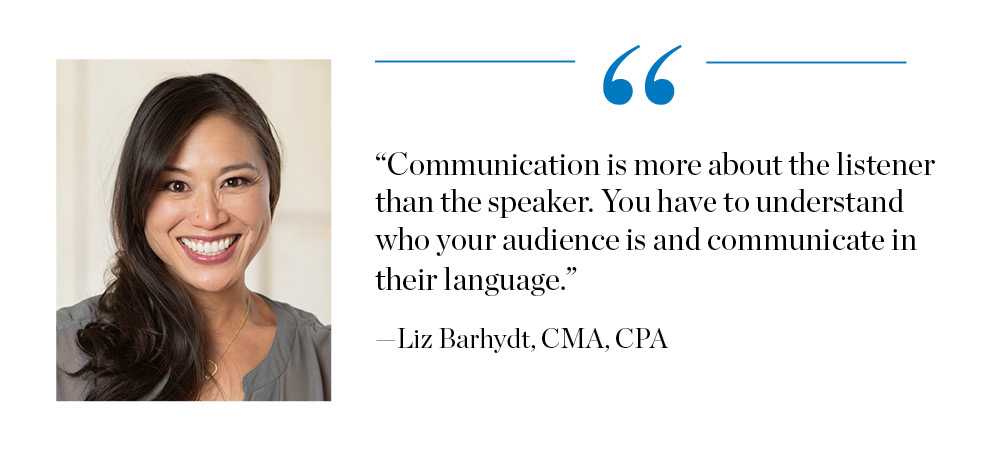You can analyze thousands of spreadsheets, but without the skill of storytelling, the numbers will never paint the entire picture. Knowing how to tell an engaging and relevant story is a must for accounting and finance professionals, who regularly communicate using data. And CFOs agree: 76% say improving finance metrics, insights, and storytelling is a critical priority for them in 2024, according to a Gartner global survey.
Whether you’re generating reports for the C-suite, crafting presentations for external stakeholders, or drafting emails and instant messages to colleagues, effective storytelling can help you bring data to life—and accelerate your career trajectory.
“Storytelling has the power to bring clarity to complex problems and translate complex data into meaningful and actionable insights,” said Tyler Ianacone, MBA, CMA, senior financial analyst at Owens Corning in Aiken, S.C. “If you can make complex matters simple, you bring tremendous value to your organization.”
In other words, strong storytellers are better equipped to show their company’s progress on strategic objectives. By synthesizing a mountain of data into actionable insights, management accountants help business leaders make better decisions—faster, says Awyana Israel Badro, CMA, senior financial accountant, International Committee of the Red Cross, Erbil, Iraq.
“Storytelling skills are vital for management accountants,” Badro said. “We serve as the communication bridge between executives and day-to-day operations by translating data into easy-to-understand, meaningful, and memorable reports.”
So how can you shape a compelling narrative that resonates with stakeholders? Here are three guideposts to help management accountants bring meaning to metrics.
Find the Narrative—and Connect the Dots
To find a story in a sea of data, it helps to apply filters. Start by identifying the strategic objectives of your audience to narrow your focus, said Liz Barhydt, CMA, CPA, the CFO for Optimism, a digital media company in Denver.
“The best way to sift through a lot of data to identify the narrative is by understanding what’s most important to the organization and the strategy it’s trying to accomplish,” she said. “You must understand what the most important goals are for your executives and teams.”
As financial data unfolds and evolves, your story must link past and present metrics. One tip to outline that narrative arc? Answer simple questions that begin to build a timeline. “What happened? And then what happened after that?” Following the trajectory of the challenge at hand will lead you to the solution—and help reveal the story.
For example, your story might explain that the company performed below expectations in a previous quarter, addressed this by hiring more sales staff, and successfully hit its targets in the most recent quarter.
“Share the why behind the number,” Barhydt said. “If you think about the why, you’ll naturally start sharing the story.”
One technique that Barhydt applies is pairing financial data with an explanatory phrase such as “That number means that…” or “To put that number in context… .” For instance, when you’re reporting monthly revenue, comparing the results to previous months or the company’s longer-term revenue targets provides perspective—amplifying the value of the data.
When Badro wades through data to spot the narrative, he seeks answers to fundamental questions: What am I looking for? Why am I looking for it? And for whom will I present the story? After defining the theme, he goes into editing mode. To make his communication clear and concise, he applies a computer-programming acronym (CRUD) to create, read, and update the story—then delete unnecessary information. “We have so much data that it can distort the story. CRUD helps me determine the story’s theme by focusing on the available data and the goals of my communication,” he said.
For Ianacone, finding the story means employing a journalist’s rigor and eye for detail—diving deep into the data to search for meaning and discover actionable insights. This approach can validate a seemingly apparent narrative—and ensure correlation data isn’t misread for causation data. And when the story seems elusive, Ianacone investigates further. “It’s best to get out into the organization and talk with the practitioners who can tell you what they’re seeing and who can pull back the veil on ambiguous data and get you the truth,” he said.
Adapt Your Storytelling for the Audience and Objective
Talking with stakeholders can help you tailor your storytelling so you don’t waste your audience’s time with irrelevant presentation details. Remember, executives generally seek high-level, actionable takeaways, while stakeholders from human resources or IT need something more targeted.
“It’s critical to know what matters most to the stakeholders in your company,” Barhydt said. “When you know what people care about most, that’s where you find the most relevant stories.”
At one of Barhydt’s former companies, each executive leader focused on a different area, so she tailored her storytelling accordingly. For the executive who often inquired about employees, Barhydt’s communications involved headcount growth and engagement survey data. When another asked about customers, she shared customer churn and subscription numbers. In meetings with the full leadership team, she spoke the language of the executive she most wanted to reach in that moment.
“Communication is more about the listener than the speaker,” Barhydt says. “You have to understand who your audience is and communicate in their language.”
Another good reminder? Although accounting and finance professionals need a granular grasp of financial data, their audiences often don’t. For instance, Ianacone’s company once had an accounting policy change that increased the minimum threshold for accruals and created challenges with the timing of certain expenses landing outside periods their budget owners expected. Previously, an accrual would immediately recognize these costs. That changed. Under Generally Accepted Accounting Principles-required thresholds given the size of the company, the timing of these expenses was subject to the vendors’ haste, or lack thereof, in invoicing for these jobs. This impacted expenses like contract labor for repairs or general cleaning and maintenance costs. Ianacone realized these changes in timing could confuse the budget owners and distort management’s ability to recognize trends.
“You have to strip out all the accounting noise and let them know what’s happening behind all that,” he says.
So how can you determine what your audience cares about most? Just ask. Solicit them via email, online survey, or in person to learn about their priorities and preferences—and how you can help. And when you meet with a group of stakeholders, aim to find out what the audience needs from your presentation. “The objective of the meeting dictates how you convey your information,” Badro said.
Learn from the Masters
The best financial storytellers don’t grow in isolation. Their skills are built and honed with help from others. Start by observing the best in action. Is your CEO or CFO a strong storyteller? Did you just watch a business leader’s stirring TED Talk? Note what makes them compelling and try to incorporate those elements in your day-to-day business conversations.
Barhydt maintains a spreadsheet to log different stories she sees and hears throughout her day—whether they’re from the morning news or watching interactions at work. Documenting these storytelling observations helps her trace the patterns of good and bad examples. “By doing this, I have a large and rich collection of stories I can access, which in turn helps me share stories more often,” she said. “The more you notice stories, the easier it becomes to tell stories.”
You might also seek mentoring from people whose storytelling skills you admire. Getting constructive feedback and developing allies can help hold you accountable as you develop your own skills. Ianacone recommends practicing your storytelling with individuals from outside the finance industry, which forces you to use more conversational language and simplify your message. Stripping out financial jargon helps ensure your message will resonate, regardless of the audience.
“If you can describe a complex problem to a friend or loved one with no background in the field, that will translate into strong storytelling with your coworkers and business leaders,” Ianacone said. “Simplicity is the key to any good storyteller’s initial message.”
Formal training can also help—whether it’s joining a communications-centric club or attending a webinar or workshop for professional development. Ianacone began building his storytelling skills while earning his MBA at the University of Florida, where he took a professional writing course that emphasized the power of direct, actionable language. Barhydt honed her skills by completing online storytelling courses and working with storytelling coaches who helped her craft specific presentations.
“It can be scary for finance and accounting professionals to come out of their comfort zone and connect, but building relationships is the best way to influence your career trajectory,” Barhydt said. “We’re trying to give meaning to numbers. For finance professionals to have any influence or impact on stakeholders, they need storytelling skills to make people care about the numbers.”





